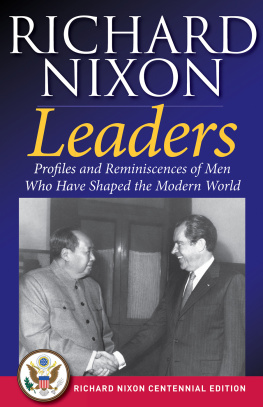Praise for
After the Fall
In a fast-moving, richly researched volume that breaks new ground, Kasey S. Pipes describes that most improbable of political journeys, the post-presidential return of Richard Nixon, this time to the private role of advising Presidents Reagan, Bush, and Clinton on foreign policy. Drawing on private Nixon family records, letters, and memos, Pipes shows the former president was far more active in helping shape Americas grand global strategyand more successfulthan previously realized, even as he suffered political exile. The story is a must for anyone wanting to understand Nixons life after Watergate.
Karl C. Rove , deputy chief of staff in the George W. Bush administration and author of The Triumph of William McKinley: Why the Election of 1896 Still Matters
Kasey S. Pipess After the Fall is a book worth reading; it is also a book worth thinking about in deeply reflective ways. At one level it is an insightful chronicle of Richard Nixons return to grace as he deftly uses his foreign policy expertise as the vehicle to establish new relationships with policy makers, politicians, and the public. Pipess depiction of the eulogies for Nixon by Senator Dole and President Clinton reads as an evocative exclamation point for this groundbreaking story of Nixons successful twenty-year return journey. Yet at another, more reflective level it is a study in the power of resilience, determination, and character in shaping a lifeNixons, to be sure, but more broadly perhaps, our own as well.
Larry Taylor, U.S. Ambassador to Estonia, 199597
Three and a half years after departing the White House in disgrace, on the occasion of his sixty-fifth birthday, Richard Nixon contemplated the future. I had to decide, he wrote, what to do with the rest of my life. The road less traveled in Nixon scholarship is the twenty-year span following his presidency. In After the Fall , Kasey Pipes fills in the missing parts of this journey. Its apt subtitle is The Remarkable Comeback of Richard Nixon . Nixons regeneration was remarkable. So is this book.
Carl Cannon, Washington Bureau Chief, RealClearPolitics
Based on his exclusive access to Nixons post-presidential papers, Kasey Pipes has written a fascinating account of Richard M. Nixons last and greatest personal crisis: rebuilding his credibility after Watergate. Pipes has mastered and carefully weighed the facts, and he tells the story well.
Bruce Buchanan, professor emeritus, Department of Government, the University of Texas at Austin
Copyright 2019 by Kasey S. Pipes
All rights reserved. No part of this publication may be reproduced or transmitted in any form or by any means electronic or mechanical, including photocopy, recording, or any information storage and retrieval system now known or to be invented, without permission in writing from the publisher, except by a reviewer who wishes to quote brief passages in connection with a review written for inclusion in a magazine, newspaper, website, or broadcast.
Regnery History is a trademark of Salem Communications Holding Corporation
Regnery is a registered trademark of Salem Communications Holding Corporation
Cover design by Jason Sunde
Cover photo by William Coupon
Author photo by Lacie Pipes
Cataloging-in-Publication data on file with the Library of Congress
ISBN 978-1-62157-284-8
ebook ISBN 978-1-62157-560-3
Published in the United States by
Regnery History
An imprint of Regnery Publishing
A Division of Salem Media Group
300 New Jersey Ave NW
Washington, DC 20001
www.RegneryHistory.com
Books are available in quantity for promotional or premium use. For information on discounts and terms, please visit our website: www.Regnery.com.
For Lacie, Lincoln, Crosby, and Betsy
and
In Memory of Brett Foster
When they kept on questioning him, he straightened up and said to them, Let any one of you who is without sin be the first to throw a stone.
John 8:7
Foreword
F ailure, Truman Capote wrote, is the condiment that gives success its flavor. In every life and in every story the fruits of victory are planted with the seeds of defeat. Every setback teaches lessons; the question is, will the defeated listen and learn?
What follows is the story of the final years of the great political tragedy of American history. Richard Nixons fall from power was Shakespearean. So was the man himself. In some ways, he symbolized the American story: born to a family of little means, finding his way in the world through his own hard work and intellect, and reaching the top of the greasy pole in Washington, D.C. But then at the height of his power, he lost it all.
Entire libraries worth of books have been written about Watergate. But comparatively little has been written about what happened after Nixon left the White House.
This book is not a book about power; it is a book about the loss of power. What does the most powerful man in the world do once he is forced into exile? What happens when the flame turns to ash? Like Napoleon Bonaparte at Elba, Nixon was a restless soul. But he didn't dream of military takeovers; he dreamed of relevance. He wanted to redeem himself and be able once again to use his greatest gifthis mind. He envisioned not a rehabilitation of his career, but a redefining of his life. He not only wanted to be accepted again, but he also wanted to help shape foreign policy for years to come. How Nixon achieved both of those goals is told in this book. And in many ways the achievement of those goals represented the greatest triumph of all for Nixonovercoming Watergate.
It should also be noted that this book doesnt deal with the specifics of Watergate. The entire ordeal predates the period of time covered in this book. Watergate is mentioned in these pages only when Nixon wrestles with the aftermath of the scandal. In these pages, we see Nixon unconfined and unbound by the trappings of presidential power.
Few books have been written about Nixons post-Watergate years. Robert Sam Ansons Exile , Stephen Ambroses Ruin and Recovery , and Monica Crowleys two books about her time with Nixon largely represent the canon on Nixons post-presidency. And none of them covers the entire twenty years from Watergate until his death in 1994. This is the first book ever to do so.
The chief reason why this rich quarry had not been mined previously is because the Nixon post-presidential papers are privately owned by the Nixon family. Although they reside at the Richard Nixon Presidential Library and Museum in Yorba Linda, California, under a deposit agreement, they are not accessible to researchers unless researchers are granted access by the family.
In 2008 I was fortunate to secure special permission from both Tricia Nixon Cox and Julie Nixon Eisenhower to use the post-presidential papers in writing this book. That access allowed me to become the first researcher to pore through the final twenty years of Nixons papersincluding his memos, letters, and notes from meetings.
Those papers revealed a man who was singed by the fire of Watergate, yes. But Nixon ultimately was strengthened by a lifetime in the fire. He was determined to make the most of the time left to him on this earth.
The story in the pages that follow is the story of resilience, of resolve, and yes, of redemption. As Charles Krauthammera columnist Nixon enjoyed readingonce wrote, everyone experiences challenges: The catastrophe that awaits everyone from a single false move, wrong turn, fatal encounter. Every life has such a moment. What distinguishes us is whetherand howwe ever come back.









